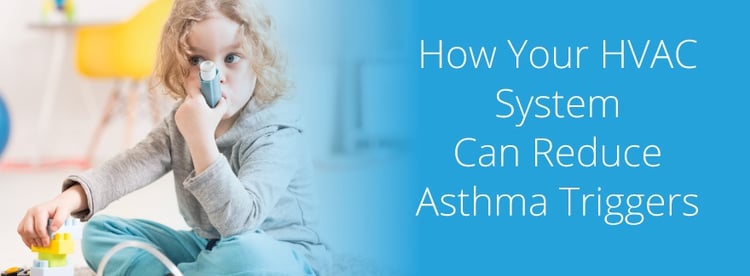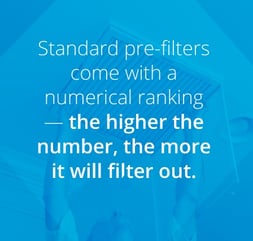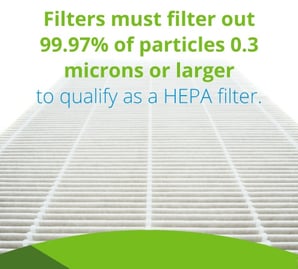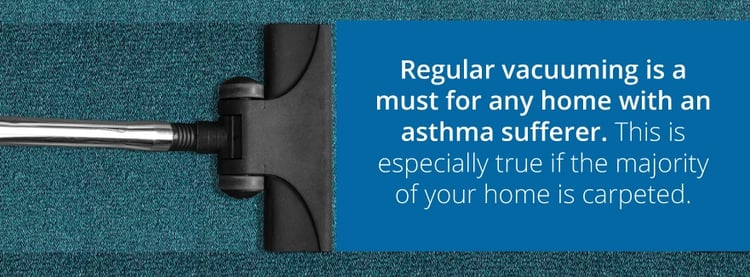
We often take the air we breathe for granted. If you’re asthmatic, though, you know every breath is precious.
According to recent studies by the American Lung Association, there are around 17 million asthma sufferers in the United States. Additionally, asthma represents the most serious chronic health concern among children and kills more than 5,000 Americans every year.

This is daunting news. However, there are some things we as a society can do to improve the lives of asthma sufferers, such as cutting down on air pollution and increasing the number of studies into asthma prevention and treatment.
Here at Smart Touch Energy, we know HVAC, and we want to do what we can to help people who are already asthma sufferers or who are concerned that young children might develop the disease. That’s why we’re turning our attention to the connections between HVAC and asthma. We want you as a homeowner and potential allergy and asthma sufferer to have the necessary tools to ease asthma with your HVAC system.
What Causes Asthma?
Simply put, asthma is a constriction of the airways in the lungs, causing wheezing, coughing and difficulty breathing. The severity of a person’s asthma can vary, from some people experiencing mild shortness of breath to others suffering from a life-threatening inability to breathe.

There are some things that can trigger an asthmatic episode or asthma attack. However, the most common of these are allergens. While not every allergy suffer will experience asthma symptoms when exposed to an allergen, it is very common for these issues to go hand-in-hand.
That’s because allergens, especially respiratory allergens, initiate an immune response that can constrict airways. Many people are familiar with a runny nose and constricted nasal passages experienced by hay fever sufferers. Now imagine the same reaction taking place within a person’s lungs. That’s an asthma attack.
Unfortunately, allergens are all around us.

In fact, according to the Asthma and Allergy Foundation of America, 8 out of 10 people are exposed to dust mites daily while 6 out of 10 are exposed to pet dander. Both of these substances are known asthma triggers.
Other common airborne asthma triggers include mold, pollen, cockroach droppings, tobacco smoke and air pollutants.
Additionally, some people suffer from exercise-induced asthma, while others are particularly susceptible to certain medications, like steroids, beta-blockers and anti-inflammatories.
Why Is Asthma on the Rise?
Many researchers have noted that asthma is on the rise, especially in developed nations. There are some well-accepted theories explaining this increase.
First of all, children in America are more often than not raised indoors. That means they are not exposed to allergens in important stages of development and thus do not become used to them.
Secondly, because people in developed countries tend to be more sedentary, they also have smaller lung capacities. This means when an asthma attack hits, it is felt much more seriously.
Finally, HVAC systems, especially those that have not been installed with allergy and asthma sufferers in mind, can recycle the same allergen-filled air, concentrating triggers and diminishing indoor air quality.
While we cannot control the first two causes, we can address the last. Therefore, we will now turn to the issue of transforming an asthma liability into a tool for controlling asthma triggers.
Start With Filtration
If you are an asthma sufferer, or you have young children that you want to protect from becoming asthma sufferers, the best place to start is with filtration.
HVAC systems installed today come with certain amounts of filtration standard. However, when it comes to the kinds of allergens and triggers that can become a problem, standard filtration often isn’t enough. So let’s explore what kind of filtration is standard and what kind of filtration may need to be added.

- Standard filtration: HVAC systems come with a standard pre-filter. This filter is used to pull dust and other airborne pollutants out of the air as it is cycled back through your system. Not only does this remove respiratory irritants from the air, but it also helps improve the functionality of your heating and cooling equipment. These filters should be changed every one to three months to ensure proper functionality of your HVAC system.
 If you want to improve your standard filtration, you can get better filters. Standard pre-filters come with a numerical ranking — the higher the number, the more it will filter out. However, the placement of this filter isn’t ideal for the kind of robust air quality control an allergy suffers would ideally want.
If you want to improve your standard filtration, you can get better filters. Standard pre-filters come with a numerical ranking — the higher the number, the more it will filter out. However, the placement of this filter isn’t ideal for the kind of robust air quality control an allergy suffers would ideally want.
- Secondary filtration: To help asthmatics, HVAC professionals can also add secondary filtration to any system. Many HVAC installation professionals will ask homeowners if there are any allergy sufferers in the home before installing a new system.
We recommend what is referred to as three-stage filtration. This combines a standard pre-filter, a special low-micron filter and an electronic filter that kills mold spores — another common asthma trigger.
Just remember to perform the manufacturer-recommended regular maintenance, as a filter is only as good as the condition it is in.
- Individual room filters: As more Americans have become concerned about air quality, individual room filters have become increasingly popular. These units come with some pretty remarkable features, and allergy sufferers report a noticeable improvement in air quality when they are used.
However, keep in mind that they only improve the air in the room where they are placed. If you find yourself suffering throughout your house, you will either need to invest in a filter for every room or move your filter as you move through the house. At that point, it would likely be more cost-effective and convenient to look for whole-house solutions.

- High-efficiency particulate air (HEPA) filters: You may have seen the designation HEPA attached to air filters in advertisements. The reason these filters are so marketable is that they meet exacting standards set by the U.S. government. To qualify as a HEPA filter according to S. National Institute for Occupational Safety and Health standards, it must filter out 99.97% of particles 0.3 microns or larger.
Unlike a sieve, HEPA filters work by pushing air through groups of fiberglass fibers, causing particles to adhere through friction. This is a much more efficient system, as it would by nearly impossible to make a sieve-type filter with holes small enough to catch things captured by a HEPA filter.
Think UV
There is another air-quality treatment method being adopted by homeowners and HVAC professionals: UV light treatments.
UV light for air quality is not new. In fact, it was first developed as a way to kill the germ that causes tuberculosis. However, when first invented, the lamps needed to produce the needed band of UV, called UV-C, were expensive. Therefore, they were mostly used in hospitals and other large institutions where germs were common.
However, the price of these UV bulbs has dropped dramatically, meaning it is easier than ever to put them to use in residential HVAC systems.

You can place them in the basement within your ductwork, aiming them into the heart of your HVAC system. This will help remove germs and other biological contaminants.
However, keep in mind that there are some asthma triggers that will not be treated by UV light. Smoke particles and dust will remain regardless of how much UV light you point at them. So while UV is a great addition to an asthma-friendly HVAC system, it should be used in conjunction with other solutions.
Reduce Humidity
As we noted above, dust mites are one of the most common and potentially asthma-triggering air pollutants found in homes.
However, researchers have also discovered dust mites prefer cool, humid environments. That means in summer, when the air conditioning is blasting, you could be producing a dust mite paradise in your home.
While air conditioners cool the air, they don’t always address the relative humidity. While cooler air will naturally be less humid, without focused dehumidification, it will still hold enough moisture to keep dust mites happy.
Additionally, carpeting and bedding tend to hold moisture longer than the ambient air, making these areas the preferred breeding grounds for mites.
That’s why regular cleaning and centralized dehumidification have proven to be the most effective way of controlling home dust mite populations.
Vacuum Regularly
Remember, the reason an HVAC system can become an issue for asthmatics is that it recycles dust particles and other allergens throughout your home.
One of the best ways to combat contaminants in your HVAC system is to eliminate them before they get recycled.

Regular vacuuming is a must for any home with an asthma sufferer. This is especially true if the majority of your home is carpeted.
To make sure you aren’t just kicking up allergens with your vacuum, make sure to invest in one that comes with onboard HEPA filtration. That way, you know the allergens are being properly removed from the environment.
Ventilate Your Home
You also want to make sure you are venting air out of your home regularly. This is especially true during the winter when germs are common and people spend more time indoors.
Your kitchen is a great place for ventilation, especially if the weather is preventing you from opening a window. Run the vent fan even if you aren’t cooking. This will pull air out of your kitchen and move it throughout your home.
You also want to always use the ventilation fan when you shower. Remember what we said about humidity and the dust mite population? Venting the steam from your shower will go far in keeping the ambient humidity of your home at a level that is inhospitable to dust mites.
This is especially important if you have recently completed a renovation. Many of the strong odors associated with new manufacturing materials can trigger an asthma attack. Even a fresh coat of paint or new carpeting can make it hard for an asthmatic to breathe. If you are doing any renovation work, make sure you are ventilating your home properly.
Keep Pollen Out
However, while getting old air out of your home might help, you also don’t want to invite contaminated air in.
This is especially true during in spring, when the pollen counts are especially high. During the pollen season, many asthmatics will retreat indoors to get away from triggers. If that’s the case with you, keep your windows shut and filtration running on maximum. Even if you have good centralized filtration, during pollen season it may be wise to invest in an additional portable filter to be used in the rooms where you spend the most time.
Keep Temperatures Level
There is another, non-particulate trigger that many asthma sufferers report: rapid drops in temperature. This is most noticeable when someone steps outside into the cold from a warm home.
However, if you aren’t careful, temperature fluctuations in your home can also trigger an attack. Make sure you watch the weather report and don’t accidentally leave a window open, causing a drop in temperature.
Avoid Strong-Smelling Cleaners
Because dust and other air pollutants are so triggering, many homeowners become extra vigilant about cleaning, especially when it comes to things like air vents and grates. While this is a good idea, there can be unintended side effects associated with strongly scented cleaners.
When using cleaners, especially in places that will be ventilated by the HVAC system, look into low-odor or fragrance-free products. Supermarkets and home supply stores are stocking more and more of these products as the number of asthma sufferers increases.
You can even make products of your own using common household ingredients like baking soda and vinegar. These products work just as well in many cases, and are usually cheaper and easier on the environment.
Don't Mask Musty Odors
If ever you enter a room and notice a musty odor, the first impulse is to find an air freshener to cover it up. However, this won’t address the underlying problem, which is usually some form of mold or spore. These spores are also asthma triggers. If you do find yourself in a musty room, you need to identify the root of the problem. Is it the carpet? Is it water damage behind an area of drywall? If so, these items need to be replaced.
Additionally, remember that strong fragrances can also be a trigger. That means if you are spraying an air freshener, you may be adding a trigger on top of a trigger.
Stop Smoking
 One of the most common asthma triggers is tobacco smoke. Unfortunately, there is little an HVAC professional can do to remove tobacco smoke triggers, especially if someone is the home is a regular smoker. Even the best filters can’t do much to remove the problem if someone is going to reintroduce it at regular intervals.
One of the most common asthma triggers is tobacco smoke. Unfortunately, there is little an HVAC professional can do to remove tobacco smoke triggers, especially if someone is the home is a regular smoker. Even the best filters can’t do much to remove the problem if someone is going to reintroduce it at regular intervals.
If you do have an asthmatic or children in your home, one of the best things you can do to improve their health, as well as yours, is to quit smoking. We know it can be difficult, but the many lungs in your home will thank you for it.
Conduct an Air Quality Assessment
As you are putting the finishing touches on your asthma-friendly HVAC system, you can conduct your own indoor air-quality assessment.
Go through each room in your home and seek potential asthma triggers. Pay close attention to every product being stored in your cabinets, the age of every carpet and the ventilation solutions installed in every room.
In the kitchen, look for evidence of increased moisture, as well as the potential for vermin such as cockroaches. Also, look under the sink and see what solvents you have stored there.
In the bathroom, look for evidence of mold, and be sure to use effective cleaners.
Go down to the basement and look for moisture as well as odor-producing chemicals. Also, make sure your furnace and other fuel-burning appliances are venting properly.
Look at carpeting and bedding in your bedrooms. If you have pets, make sure they haven’t turned an uninspected corner into a litter box.
In the living room, look at the upholstery on your furniture. Just like bedding, upholstery can be a hiding place for mites and other triggers.
Finally, in the garage, look for stored chemicals and be sure you have proper exhaust ventilation for your car.
For further guidance on identifying triggers in your home, turn to a free expert-produced tool, like this one from the Asthma Initiative of Michigan. Furthermore, if you are concerned about a particular room or are unsure of how to address the potential triggers within it, contact an HVAC professional and inform them of your concerns. They will have guidance and industry-best practices that will help you find the ideal HVAC system for you and your family.
Regular Maintenance
Finally, you want to make sure your HVAC system is in peak operating condition. Things like a poorly performing furnace or a leaky central air conditioner can make asthmatic triggers worse.

Unfortunately, most homeowners cannot assess the particularities of HVAC systems like a professional can. While you can do a lot — such as changing filters and doing regular superficial cleaning — to improve air quality, there are small issues that will certainly go undetected. Those small things can still have a big impact on an asthma sufferer. A regular HVAC tuneup will not only reduce the potential for unseen contaminants, it will also help extend the life of your system while saving money in the long run.
Trust Smart Touch Energy
Addressing asthma issues within your HVAC system is a countrywide operation. However, if you are lucky enough to live in Maine, Massachusetts, Rhode Island, New Hampshire, Connecticut, New York, New Jersey, Pennsylvania, Maryland or Delaware, you also have an HVAC professional partner you can count on.
Although we started with a focus on heating oil, Smart Touch Energy has earned a reputation for being experts on HVAC systems. Our professional and certified experts are here to provide you with regular maintenance and guidance on future purchases. They can help you make the small changes necessary to transform your HVAC system and aid the asthma sufferer in your home.
Regular maintenance is especially important, and we are here to make routine tuneups affordable. Our air conditioning tuneup service is exactly what you need to make sure your system is in peak condition and is thoroughly clean. Not only will this help with air quality, but it will also give you peace of mind, as air conditioning malfunctions always seem to strike at the most inconvenient times.
If you are ready to take the next step in making your HVAC system asthma-friendly and want to find an HVAC partner that is both courteous and experienced, look no further than Smart Touch Energy. Contact us today for pricing and details about all we can do to help you meet your home air-quality goals.



